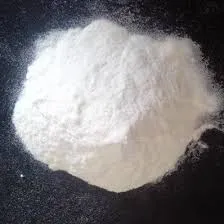
Јул . 31, 2024 22:36 Back to list
Understanding the Properties and Applications of Redispersible Polymer Powders in Construction and Coatings
Understanding Redispersible Polymer Powders
Redispersible polymer powders (RDPs) are an essential component in modern construction and building materials, known for their versatility and enhancing properties. These fine powders are derived from disperse polymer emulsions, which are first spray-dried to produce a free-flowing powder form. While they appear as simple additives, RDPs play a critical role in improving the performance of various applications, particularly in cement-based systems, adhesives, and coatings.
Composition and Properties
Redispersible polymer powders are primarily made from synthetic polymers such as ethylene-vinyl acetate (EVA), styrene-acrylic, and vinyl acetate-ethylene (VAE) copolymers. They are designed to rehydrate and reconstitute into a polymer film upon mixing with water. This unique characteristic allows them to provide cohesive properties that enhance adhesion, flexibility, and durability of the final product.
When added to dry mixed mortars or tile adhesives, RDPs improve the overall performance by increasing workability and providing better adhesion to substrates, including ceramic tiles, plaster, and concrete surfaces. Moreover, they contribute to enhanced water resistance, improved crack resistance, and increased elasticity, making them ideal for construction applications where durability and resilience are crucial.
Applications in Construction
RDPs find widespread use in various construction materials, encompassing the following applications
1. Tile Adhesives In tile adhesives, RDPs improve the bond strength and shear resistance, allowing tiles to adhere more effectively to the underlying surface. This is crucial in ensuring that tiles remain firmly in place, particularly in areas exposed to moisture.
redispersible polymer powder wiki

2. Cement-based Systems RDPs enhance the workability and performance of cement-based products such as mortars and renders. Their inclusion leads to superior adhesion and flexibility, making these materials more responsive to temperature fluctuations and building movements.
3. Coatings In coatings, RDPs improve the film formation and mechanical properties of paints and sealants. They contribute to a smooth finish, increased durability, and resistance to environmental factors such as UV rays and moisture.
4. Self-Leveling Compounds RDPs play a vital role in self-leveling compounds by helping maintain workability while ensuring good adhesion to the substrate. This property is essential for achieving a smooth, even surface.
Environmental Considerations
The production and application of redispersible polymer powders align with modern environmental standards, as many manufacturers are now focusing on sustainability. RDPs can enhance the performance of building materials without the need for significant amounts of conventional polymers, leading to a reduction in the overall carbon footprint of construction practices. Additionally, the use of RDPs can contribute to energy-saving measures in buildings by improving insulation properties.
Conclusion
In conclusion, redispersible polymer powders are crucial players in the field of construction and building materials, providing a range of benefits that enhance adhesion, flexibility, and durability. Their ability to reconstitute and form a cohesive film makes them particularly valuable in applications ranging from tile adhesives to cement-based products. As the construction industry continues to evolve, the role of RDPs in advancing product performance and supporting sustainable practices will undoubtedly expand, solidifying their position as indispensable materials in modern construction.
-
What Is HPMC: Meaning,Applications
NewsApr.02,2025
-
Redispersible Polymer Powder (Rdp): Uses, Price, And Suppliers
NewsApr.02,2025
-
Hydroxyethyl Cellulose (Hec): Uses, Suppliers, And Buying Guide
NewsApr.02,2025
-
Hpmc (Hydroxypropyl Methylcellulose): Applications, Suppliers, And Buying Guide
NewsApr.02,2025
-
Guide to Mortar Bonding Agent
NewsApr.02,2025
-
Buying Guide to Redispersible Powder
NewsApr.02,2025







